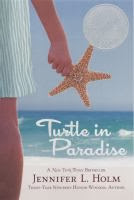Image Source:
Books in
Print (via TWU Databases). Accessed November 11, 2013. http://ezproxy.twu.edu:2125/DetailedView.aspx?hreciid=|28467717|38172476&mc=USA
Holm,
Jennifer L. 2010. Turtle in Paradise.
New York: Random House. ISBN 9780606238779
Turtle in Paradise by Jennifer L. Holm is the story of a
young girl sent to live in the Florida Keys with her cousins during 1935.
Nicknamed “Turtle,” the girl finds herself surviving and adapting to living
with her Aunt Minnie and scoundrel cousins. During that period in history,
money was scarce and families often dispersed in order for parents to find work.
In the Keys, everyone has a nickname and this gives a sense of
the unique essence of island life. The first page in the book is a definition
of the word “conch.” The conch sponge is
gathered for sale and throughout the story is a recurring theme. Holm uses
vivid descriptions of the surroundings, as well as the heat and tropical
weather. When a hurricane hits and Turtle fears for her life beside her
cousins, the reader almost feels as if they too are in danger of being swept
away by the ocean waves.
The
theme is one of survival, love and family. Over time, Turtle builds
relationships and discovers that the old woman named “Nana Philly” is actually
her maternal grandmother. The concept of wanting to have a home to share with
her mother is a timeless desire for a stable family life. Turtle in Paradise is an excellent resource for sharing what life
was for some children during the Great Depression. It is not overly graphic in
its descriptions of poverty, but does explain how hunger is connected to
poverty during hard times. Young readers will enjoy the topic of Turtle and her
cousins searching and finding buried treasure.
At
the close of the reading, the author provides an extensive author’s note. Here,
photographs are provided for the real sites of different locations within the
novel. In addition, some of the characters are based upon real people whose
photos are included. A brief list of Web sites are included, along with
resources for further reading about the Great Depression and the Labor Day
hurricane that hit the Florida Keys in 1935.
Turtle in Paradise received a number of award nominations including the Bluebonnet Award (2012) and the California Young Reader Medal (2013). As Stephanie Malosh writes in her School Library Journal Review, "Readers who enjoy melodic, humorous tales of the past won't want to miss it" (Books in Print 2010).
References:
References:
Books in
Print (via TWU Databases). Accessed November 11, 2013. http://ezproxy.twu.edu:2125/DetailedView.aspx?hreciid=|28467717|38172476&mc=USA
Holm,
Jennifer L. 2010. Turtle in Paradise.
New York: Random House. ISBN 9780606238779


